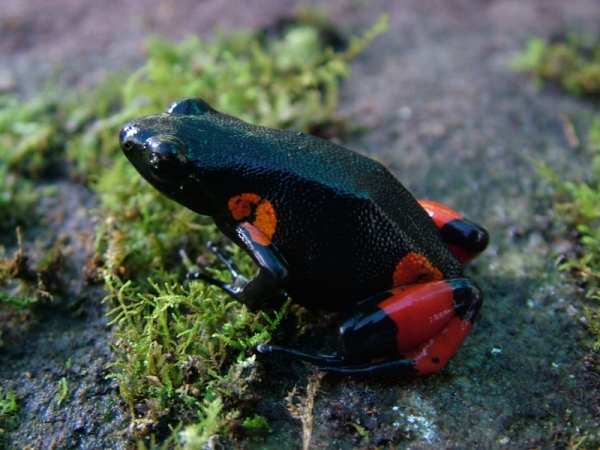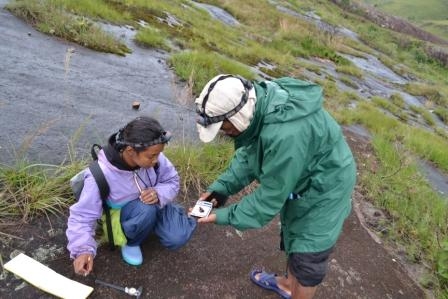
Mantella cowanii is classified as Endangered by the IUCN red list of threatened species due to its very restricted area of occupancy to a few sites. In addition to that, the species is mainly threatened by the habitat loss. The conservation efforts through the Action Plan Mantella cowanii (APMC) seem to be positive for the species has been down listed from Critically Endangered to Endangered in 2014.
Though, there is a lack of information concerning the ecology and biology of this species. In order to have a better understanding of the population size, microhabitat requirements and behavior of M. cowanii, Madagasikara Voakajy has carried out a survey before, during and after reproduction periodin Fohisokina and Antsirakambiaty, a research funded by the Chester Zoo.
Field work
We had three periods of fieldwork. First of all, we had a pilot study in December 2014 to better design the main survey in January-February 2015.The pilot took place at the savannah of the Fohisokina during four days between December 9th and 12thbefore the reproduction period. After that, the first period of the main study was carried out in January-February during their production period, for ten days. It took place in two kinds of habitat: the savannah of Fohisokina and the riparian forest of Antsirakambiaty. Then, we repeated the study in April 2015 in the post reproduction period only in Fohisokina. During the main study, we had collected four types of data: the microhabitat use, the behaviors of individuals, the population structure and the habitat structure and preference.
Good time for appointments
Bibliography and this survey agree about one point: if you want to meet a lot of Arlequin mantellas, the best moment for that is early in the morning, from 5 to 7 a.m. In this study, we had another peak of observations: between 4p.m to 6 p.m. During these two identified peaks, they are generally found on rocks or rock bolder.
Microhabitat use and habitat preference
From the pilot to the end of the study, we could count 452 observations and individual calls of Mantella cowanii. The peak of observations was found in December, during the pre-reproduction period with 282 including 235 individual observations and 47 calls. In our main study, it has first dropped to 172 individual observations in January-February and then leveled out to zero observation in April.Therefore, the density of Mantella cowani inFohisokina during this study is about 1 229 individuals per hectare.The sex-ratio was 26 males for 24 females.
Mantella cowanii frequently uses rock or rock bolder as substrate, cave or hole, grass, moss, and grass. Males spent most of the time on dry rocks while females are more likely to be found on humid rock or in grass. On moss or in stream, you have more chance to find males than females.
After comparing occupied quadrates to non occupied ones, we could conclude that Mantella cowanii prefers microhabitat with high percentage of rock cover, high number of rock, and great size of rock. Even if there was a low percentage of occupancy of grass, the grassy habitat without a rock bolder wasnever used by the frog.The presence of Mantella cowanii is definitely related to rock. In addition to being rocky, the area occupied by Mantella cowaniiis more covered by litter, understory, fern, moss, and vegetation than non-occupied places, but these difference were not significant.
Behaviors
Concerning its behaviors, Mantella cowanii rests a lot. Jumping is the second main activity, before walking, feeding and drinking.
As frogs are poikiloterm animals, the ambient conditions have an impact on its behaviors. For instance, we found that ambient air temperature has a significant influence onthe activity of this frog species. Indeed, the animal was active outside of the refugebetween 12°C and 24°C. The thin skin of the frog requires it to stay in humid microhabitatssuch a hole or cave when the temperature increased. Otherwise, the temperature of thesubstrate affected the body temperature of the frog. The greatest activity was during the full sun in the early mornings and/or late afternoon after heavy rains.
Further studies
Even if there we couldn’t find any Halloween Mantella frog in Antsirakambiaty, further studies should be carried out to know the current distribution and the difference between the two populations of Mantella cowani in savannah and riparian forest. We should also study the habitat use during hibernation.
Besides, researches about awareness, perception and behaviors of people living nearby regarding the species conservation is important for an efficient strategy of conservation of the species. In fact, local communities are more likely to interact with this wild species than scientists and then, they play an important role in monitoring and conservation of this species and its habitat.




